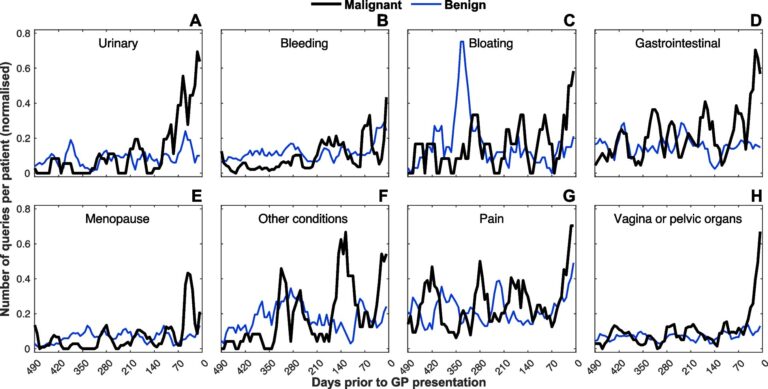Time series graph outlining the number of online search queries by individual category within the study cohort. The time series graph outlines the number of online search queries made per patient within each symptom category, stratified by outcome (benign/malignant), up to 490 days prior to GP referral. Online search activities can identify symptomatic gynecological cancer patients early. credit: BMC public health (2024). DOI: 10.1186/s12889-024-17673-0
× close
Time series graph outlining the number of online search queries by individual category within the study cohort. The time series graph outlines the number of online search queries made per patient within each symptom category, stratified by outcome (benign/malignant), up to 490 days prior to GP referral. Online search activities can identify symptomatic gynecological cancer patients early. credit: BMC public health (2024). DOI: 10.1186/s12889-024-17673-0
Search engine data could be used to detect cases of gynecological cancer earlier, in some cases months earlier than a referral from a general practitioner, according to a new study.
A study led by researchers at Imperial and colleagues from the UCL Computer Science Department and Microsoft reveals differences in online search data between people with benign gynecological conditions and people with gynecological cancers, particularly ovarian cancer. has been identified. This research BMC public health.
Ovarian cancer is the deadliest gynecological cancer and the sixth most common cancer in the UK, with around 7,400 people diagnosed each year and more than 4,000 dying from the disease each year. Currently, there are no screening programs to detect the disease early.
Using Google data, researchers focused on differences in search patterns 360 days before a GP referral and found that this resulted in good predictive accuracy around 60 days before a GP referral.
Different symptom patterns were also observed between the benign and cancerous groups. For example, a sharp increase in urinary symptoms was observed 140 days before GP referral, whereas symptoms of abdominal bloating and pelvic pain appeared to appear later (70 days) compared to the benign group.
It is hoped that a larger study will confirm whether search engine data can be used as an early disease detection tool to speed the diagnosis of gynecological cancers, particularly ovarian cancer.
“Ovarian cancer is one of the most deadly cancers for women,” said Dr. Surjan Saso, senior author and principal investigator of the study and a gynecologic cancer surgeon in Imperial’s Department of Metabolism, Digestion and Reproduction. “In advanced stages, the prognosis is poor.” The focus therefore continues to be on promoting early detection of the disease, but there are still no screening programs that allow this.
“Our research, in collaboration with computer scientists at UCL and Microsoft, led by Professor Ingemar Cox and Dr Elad Yomtov, respectively, aims to distinguish between women with malignant gynecological conditions and those with benign gynecological conditions. We showed that online search data may be used to help women who use the Internet, especially women who may be at higher risk of ovarian cancer. It may be possible to build early detection tools that can identify
“We hope to raise funding in the near future to develop a multicenter study that can confirm these findings in a larger cohort.”
Great potential for disease screening
Previous research led by researchers at Imperial showed that loyalty card data could be used to identify cases of ovarian cancer early. However, this new study uses data from internet search engines used by a large proportion of the population (both in the UK and globally).
Dr. Jennifer F. Barcroft, lead author of the study from Imperial’s Department of Metabolism, Digestion and Reproduction, said: “Our results demonstrate that search engine data can be used to understand how conditions exist. “This shows that it is possible, and that this could be useful for the following applications.” Considering that we have revealed different symptom patterns between benign diseases and gynecological cancers, early detection of the disease is possible.
“With almost 98% of people in the UK having access to the internet, its use for health purposes is increasing.Given the prevalence of the internet around the world, online search data has a huge impact on health and disease screening. The study will increase interest in this new field of research.”
Professor Ingemar Cox, senior author of the study from UCL Computer Science, said: “Our current paper incorporates clinical research to confirm that an individual’s risk of some diseases can be determined based on their web search behavior. “This is a significant extension of previous research.” Therefore, the search may provide an easy and inexpensive method for disease screening. Of course, this raises important ethical and privacy concerns that need to be resolved. ”
Written consent was obtained from study participants to use online search data from Google Takeout files. This data was then anonymized.
For more information:
Jennifer F. Barcroft et al, Early Detection of Gynecologic Malignancies Using Online Search Activities, BMC public health (2024). DOI: 10.1186/s12889-024-17673-0


